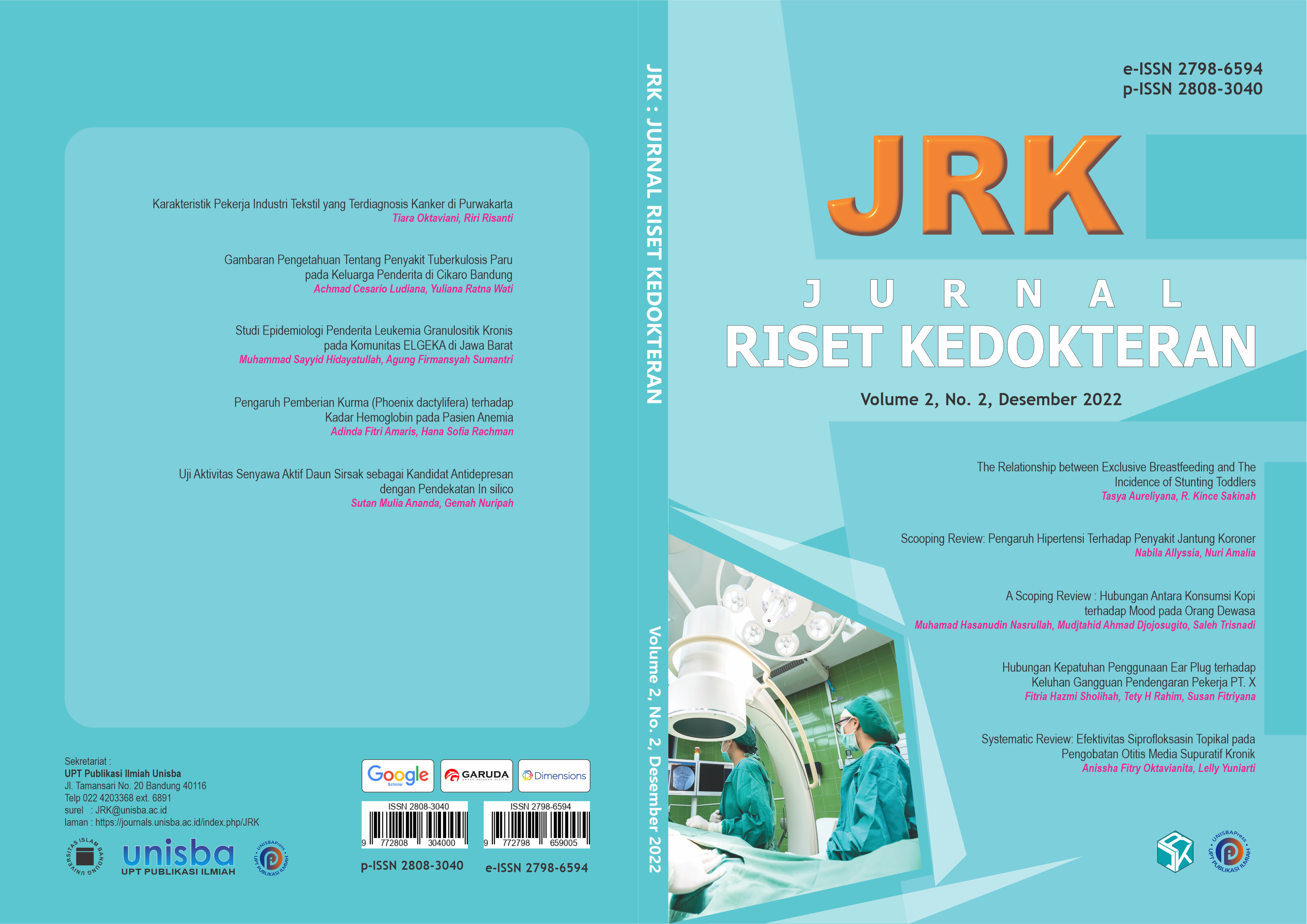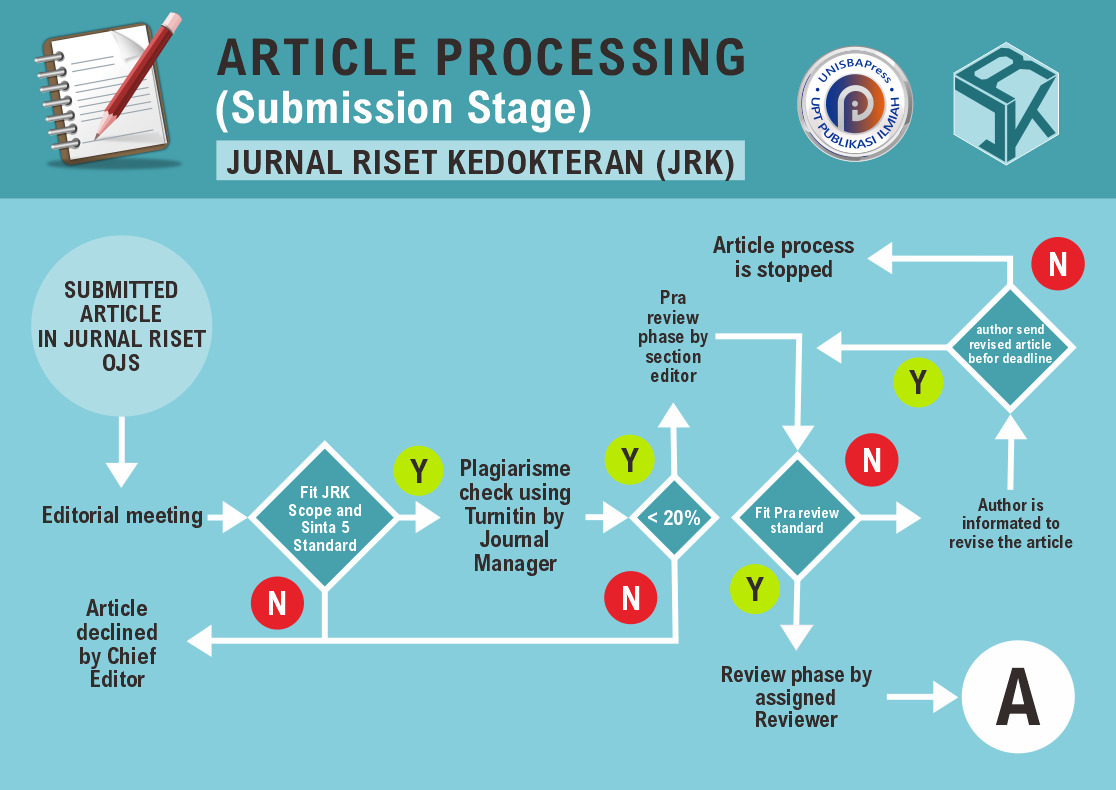The Relationship between Exclusive Breastfeeding and The Incidence of Stunting Toddlers
DOI:
https://doi.org/10.29313/jrk.vi.1437Keywords:
Stunting, ASI Eksklusif, BalitaAbstract
Abstract. Stunting is a condition when toddlers have a length or height that is less than their average age. Indonesia is the third country with the highest prevalence in the Southeast Asia region, which is 43.8%. Cemara Wetan Village has the highest prevalence of stunting, which is 34.40% of all villages in Indramayu district. One of the efforts to prevent stunting is by providing adequate nutrition from an early age through exclusive breastfeeding. This study aims to determine the relationship between exclusive breastfeeding and the incidence of stunting under five in Cemara Etan Village, Indramayu Regency. This study uses a quantitative research method with an analytical observational research design with a cross-sectional approach. This study used a breastfeeding questionnaire for mothers of toddlers and secondary data for measuring body mass index of toddlers. The analysis technique uses univariate and bivariate analysis using the chi square test. The results showed that there was a significant relationship between exclusive breastfeeding and the incidence of stunting in children under five in Cemara Wetan Village, Indramayu Regency with (p = 0.012, OR = 0.304).\
Abstrak. Stunting merupakan suatu kondisi pada saat balita memiliki panjang atau tinggi badan yang kurang dibandingkan anak rerata usianya. Indonesia merupakan negara ketiga dengan prevalensi tertinggi di regional Asia Tenggara yaitu sebanyak 43,8%. Desa Cemara Wetan memiliki prevalensi angka stunting tertinggi yaitu 34,40% dari seluruh desa di kabupaten Indramayu. Salah satu usaha pencegahan stunting yaitu dengan pemberian nutrisi adekuat sejak usia dini melalui ASI eksklusif. Penelitian ini bertujuan untuk mengetahui hubungan ASI eksklusif terhadap kejadian balita stunting di Desa Cemara Etan Kabupaten Indramayu. Penelitian ini menggunakan metode penelitian kuantitatif dengan desain penelitian observasonal analitik dengan pendekatan crossectional. Penelitian ini menggunakan kuesioner ASI pada ibu balita dan data sekunder pengukuran indeks massa tubuh balita. Tekhnik analisisnya menggunakan analisis univariat maupun bivariat menggunakan chi square test. Hasil penelitian memperlihatkan bahwa terdapat hubungan signifikan antara pemberian ASI Eksklusif dengan kejadian stunting pada balita di Desa Cemara Wetan Kabupaten Indramayu dengan (p=0,012, OR=0,304).
References
K. K. RI, “Buletin Stunting,” Pus. data dan Inf. Kemenkes RI, vol. 301, no. 5, 2018.
D. K. J. Barat, Prevalensi Stunting Di Jawa Barat. Dinas Kesehatan Jawa Barat, 2018.
A. D. N. Yadika, K. N. Berawi, and S. H. Nasution, “Pengaruh stunting terhadap perkembangan kognitif dan prestasi belajar,” J. Major., vol. 8, no. 2, pp. 273–282, 2019.
E. M. Sari, M. Juffrie, N. Nurani, and M. N. Sitaresmi, “Asupan protein, kalsium dan fosfor pada anak stunting dan tidak stunting usia 24-59 bulan,” J. Gizi Klin. Indones., vol. 12, no. 4, p. 152, 2016, doi: 10.22146/ijcn.23111.
Y. P. Istianti, “PROFESI Volume 10 / September 2013 – Februari 2014,” Hub. Antara Masukan Cairan Dengan Interdialytic Weight Gains Pada Pasien Chronic Kidney Dis. Di Unit Hemodialisis Rs Pku Muhammadiyah Yogyakarta, vol. 10, no. 26, pp. 14–20, 2014.
L. O. Alifariki, L. Rangki, H. Haryati, R. Rahmawati, S. Sukurni, and W. O. Salma, “Risk Factors of Stunting in Children Age 24-59 Months Old,” Media Keperawatan Indones., vol. 3, no. 1, p. 10, 2020, doi: 10.26714/mki.3.1.2020.10-16.
M. Muldiasman, K. Kusharisupeni, E. Laksminingsih, and B. Besral, “Can early initiation to breastfeeding prevent stunting in 6-59 months old children?,” J. Heal. Res., vol. 32, no. 5, pp. 334–341, 2018, doi: 10.1108/JHR-08-2018-038.
I. Glanny Anindya, H. Salimo, Y. Lanti, and R. Dewi, “The Association between Exclusive Breastfeeding, Maternal Nutritional Status, Maternal Zinc Intake, and Stunting in Infants Aged 6 Months,” J. Matern. Child Heal., vol. 5, no. 1, pp. 35–48, 2020, [Online]. Available: https://doi.org/10.26911/thejmch.2020.05.01.05
K. E. Kusuma and Nuryanto, “Faktor Risiko Kejadian Stunting pada Anak Usia 6-7 Tahun,” J. Ilm. Kesehat., vol. 4, no. 1, pp. 90–97, 2022, doi: 10.36590/jika.v4i1.226.
S. M. Goudet, B. A. Bogin, N. J. Madise, and P. L. Griffiths, “Nutritional interventions for preventing stunting in children (Birth to 59 months) living in urban slums in low-and middle-income countries (LMIC),” Cochrane Database Syst. Rev., vol. 2019, no. 6, 2019, doi: 10.1002/14651858.CD011695.pub2.
J. U. Condo, A. Gage, N. Mock, J. Rice, and T. Greiner, “Sex differences in nutritional status of HIV-exposed children in Rwanda: a longitudinal study,” Trop. Med. Int. Heal., vol. 20, no. 1, pp. 17–23, 2015.
B. Syeda, K. Agho, L. Wilson, G. K. Maheshwari, and M. Q. Raza, “Relationship between breastfeeding duration and undernutrition conditions among children aged 0–3 Years in Pakistan,” Int. J. Pediatr. Adolesc. Med., vol. 8, no. 1, pp. 10–17, 2021, doi: 10.1016/j.ijpam.2020.01.006.
M. S. Rengma, K. Bose, and N. Mondal, “Socio-economic and demographic correlates of stunting among adolescents of Assam, North- east India,” Anthropol. Rev., vol. 79, no. 4, pp. 409–425, 2016, doi: 10.1515/anre-2016-0030.
M. Asfaw, M. Wondaferash, M. Taha, and L. Dube, “Prevalence of undernutrition and associated factors among children aged between six to fifty nine months in Bule Hora district, South Ethiopia,” BMC Public Health, vol. 15, no. 1, pp. 1–9, 2015, doi: 10.1186/s12889-015-1370-9.
A. Nshimyiryo et al., “Risk factors for stunting among children under five years: A cross-sectional population-based study in Rwanda using the 2015 Demographic and Health Survey,” BMC Public Health, vol. 19, no. 1, pp. 1–10, 2019, doi: 10.1186/s12889-019-6504-z.
A. K. Manggala et al., “Risk factor of stunting in children aged 24-59 months,” vol. 58, no. 5, pp. 205–212, 2018.
C. H. D. Fall et al., “Association between maternal age at childbirth and child and adult outcomes in the offspring: A prospective study in five low-income and middle-income countries (COHORTS collaboration),” Lancet Glob. Heal., vol. 3, no. 7, pp. e366–e377, 2015, doi: 10.1016/S2214-109X(15)00038-8.
N. Sulung, “Kajian Penyebab Stunting Anak Usia 24 - 59 Bulan Diwilayah Kerja Puskesmas Padang Gelugur Kabupaten Pasaman,” J. Pembang. Nagari, vol. 5, no. 1, p. 1, 2020, doi: 10.30559/jpn.v5i1.165.
S. A. Sampe, R. C. Toban, and M. A. Madi, “Hubungan Pemberian ASI Eksklusif dengan Kejadian Stunting pada Anak Balita,” Matern. Neonatal Heal. J., vol. 3, no. 1, pp. 7–11, 2022, doi: 10.37010/mnhj.v3i1.498.
R. Tiwari, L. M. Ausman, and K. E. Agho, “Determinants of stunting and severe stunting among under-fives: Evidence from the 2011 Nepal Demographic and Health Survey,” BMC Pediatr., vol. 14, no. 1, pp. 1–15, 2014, doi: 10.1186/1471-2431-14-239.
I. D. A. Indonesia, Buku Ajar Nutrisi Pediatrik dan Penyakit Metabolik. Jakarta: IDAI, 2011.
C. R. Martin, P. R. Ling, and G. L. Blackburn, “Review of infant feeding: Key features of breast milk and infant formula,” Nutrients, vol. 8, no. 5, pp. 1–11, 2016, doi: 10.3390/nu8050279.
H. Kismul, P. Acharya, M. A. Mapatano, and A. Hatløy, “Determinants of childhood stunting in the Democratic Republic of Congo: Further analysis of Demographic and Health Survey 2013-14,” BMC Public Health, vol. 18, no. 1, pp. 1–14, 2017, doi: 10.1186/s12889-017-4621-0.
M. De Onis et al., “The world health organization’s global target for reducing childhood stunting by 2025: Rationale and proposed actions,” Matern. Child Nutr., vol. 9, no. S2, pp. 6–26, 2013, doi: 10.1111/mcn.12075.
T. Astika, E. Permatasari, and A. Syafruddin, “Early Initiation of Breastfeeding related to Exclusive Breastfeeding and Breastfeeding duration in rural and urban arean in Subang, West Java, Indonesia,” J Heal. Res, vol. 30, no. 5, pp. 337–345, 2016, doi: 10.14456/jhr.2016.46.
C. P. Stewart, L. Iannotti, K. G. Dewey, K. F. Michaelsen, and A. W. Onyango, “Contextualising complementary feeding in a broader framework for stunting prevention,” Matern. Child Nutr., vol. 9, no. S2, pp. 27–45, 2013, doi: 10.1111/mcn.12088.













